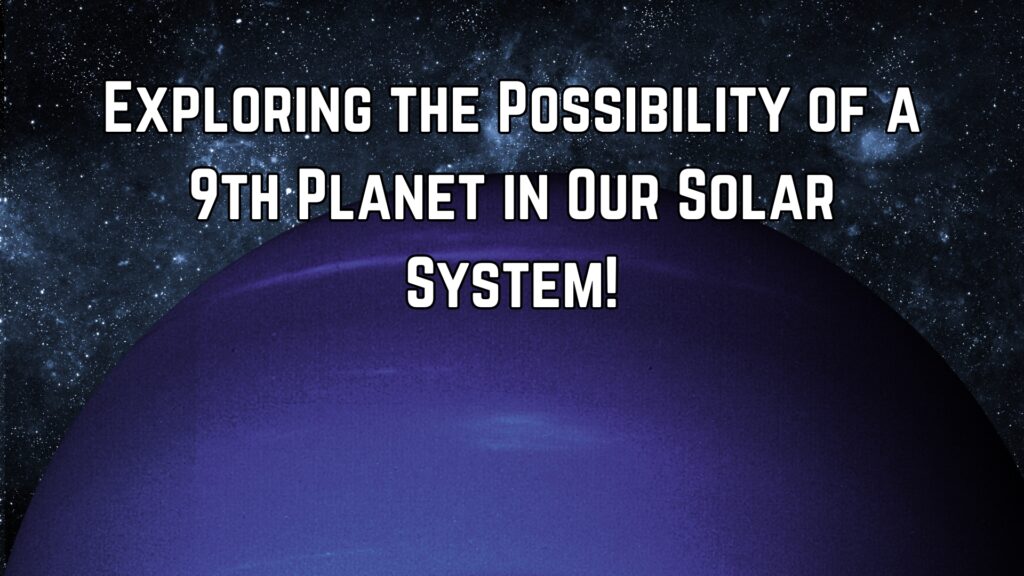In the far reaches of our solar System, beyond Neptune’s orbit, something unusual is happening. A mysterious force has been pushing around icy objects, clustered in orbits that cannot be explained by the known planets alone. Scientists think this could be due to a new planet called Planet 9. Astronomers have been searching the outer solar System for signs of a theoretical ninth planet for almost a decade without success. However, experts believe we may finally be on the cusp of finding it.
View our blog about Mystery Signal from Deep Space: Unraveling the 22-Minute Transmission
In the Solar System’s outer regions, a distant icy world might be waiting to be discovered. A new telescope will begin scanning the sky next year, potentially leading to the long-awaited discovery of this mysterious planet. While the solar System currently has eight recognized planets, astronomers have suggested that a ninth world, known as “Planet Nine,” could exist in the farthest reaches of our cosmic neighborhood. This hypothetical planet, distinct from Pluto, could be a gas or ice giant located billions of miles beyond the known planets. Its potential existence can reshape our understanding of the origins and development of the Solar System.

Scientists have predicted its size, distance from the sun, and orbit. However, they have not been able to locate it yet. The search for this potential ninth planet could be resolved with the Vera C. Rubin Observatory, scheduled to open in 2025. Experts believe they may finally find Planet Nine within the next few years or conclusively rule out its existence.
The idea of a ninth planet in our solar System came about after discovering Uranus in 1781 and Neptune in 1846, more than 3,000 years after the Babylonians first spotted the other planets. These discoveries hinted at the vastness of our solar System, leading to the intriguing possibility of more undiscovered worlds. Despite the initial classification of Pluto as the ninth planet, no other full-fledged planets beyond Neptune or the Kuiper Belt have been located. As astronomers delved deeper into the outer solar System, it seemed increasingly unlikely that they had missed a planet as large as what was being proposed.
In 2004, scientists discovered Sedna, a potential dwarf planet beyond the Kuiper Belt. Sedna exhibited an unusual orbit around the sun, indicating the presence of another large mass in the outer solar System exerting gravitational influence on it. This hypothesis was difficult to prove due to a lack of information. In 2014, astronomers identified a smaller object in the Kuiper Belt, named 2012 VP113, with a similar strange orbit to Sedna’s. This discovery suggested that more eccentric trans-Neptunian objects (TNOs) are yet to be found.
The discovery of a shared “kink” in the orbits of Sedna and 2012 VP113 stimulated the curiosity of Caltech astronomers Mike Brown and Konstantin Batygin. Due to this intriguing irregularity, these objects appeared briefly dipping below the known planets’ orbit plane. This suggested that some gravitational force, possibly from an asteroid clump, a dwarf planet, or even a full-fledged world, was influencing these distant objects.
Even after the pair realized that a ninth planet was possible, they decided to withhold their findings until they could come up with another, less controversial explanation. However, they then found four more TNOs with matching, misshaped orbits, suddenly making a missing planet seem like the most logical explanation.
At the time, the same scientists calculated that there was just a 2% chance that all six TNOs they had studied shared their orbital oddities thanks to random chance. So, in 2016, Brown and Batygin published their “Planet Nine hypothesis,” which has captured the public’s imagination ever since.
Since 2016, Brown, Batygin, and others have been actively searching for Planet Nine. Although they have not yet found it, they have discovered even more eccentric TNOs, bringing the total to 13 and further strengthening the case for its presence. These discoveries also provide more information about Planet Nine’s potential size, distance from the sun, and orbital trajectory through the Solar System.
At this distance, it could take between 5,000 and 10,000 years for Planet Nine to complete a single orbit around the sun. Its orbit is likely highly elliptical, leading to significant variations in its distance from the sun over time. Furthermore, it probably orbits on a different plane than the rest of the planets, which adds to the challenge of locating it.
So, why haven’t we spotted Planet Nine yet? The answer is simple: it’s “very, very far away,” according to Brown. Additionally, the researchers initially had no idea where the planet was on its predicted orbital path, so they had to search a huge region of the sky to find it, similar to searching for “a single white whale in an ocean,” as Brown described it. Researchers have analyzed thousands of images from various sky surveys along the proposed orbital path of Planet Nine, searching for objects that exhibit movement over time.
If Planet Nine is located at the farthest point in its orbit, a powerful telescope will be required to spot it. Brown and Batygin are currently analyzing data from Japan’s Subaru Telescope in Hawaii, which has a better chance of finding the planet than Pan-STARRS. If this survey is unsuccessful, they plan to use the upcoming Vera C. Rubin Observatory in Chile, which is currently under construction. This ground-based telescope, equipped with the world’s largest digital camera, will allow researchers to peer farther into the Solar System than any previous telescope, similar to how the James Webb Space Telescope has enabled researchers to look farther across the observable universe than ever before.
Although scientists are still divided over the existence of Planet Nine, they all agree that actually finding the elusive world would likely be the most significant solar system discovery of the century
Visit Our YouTube Channel